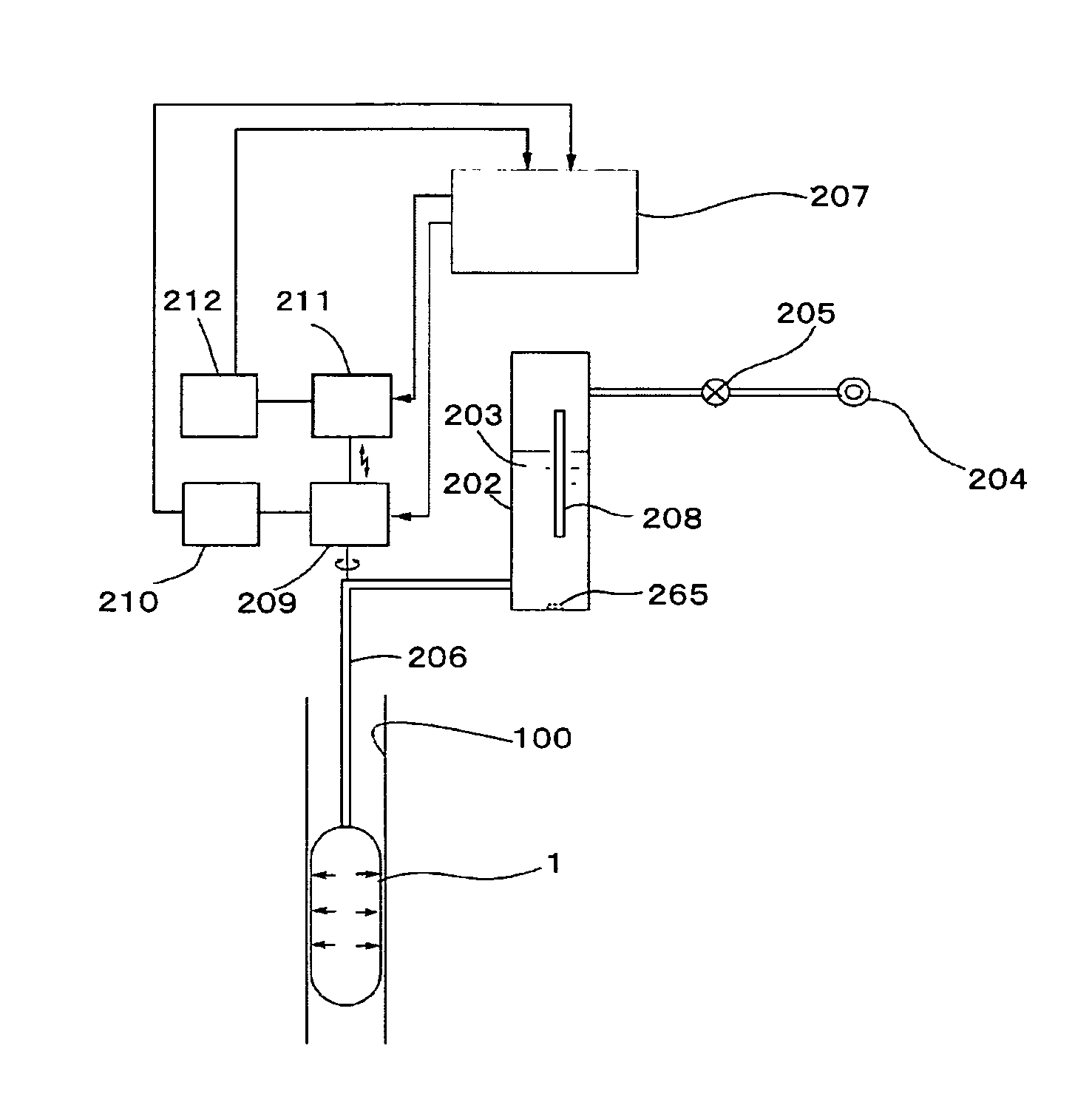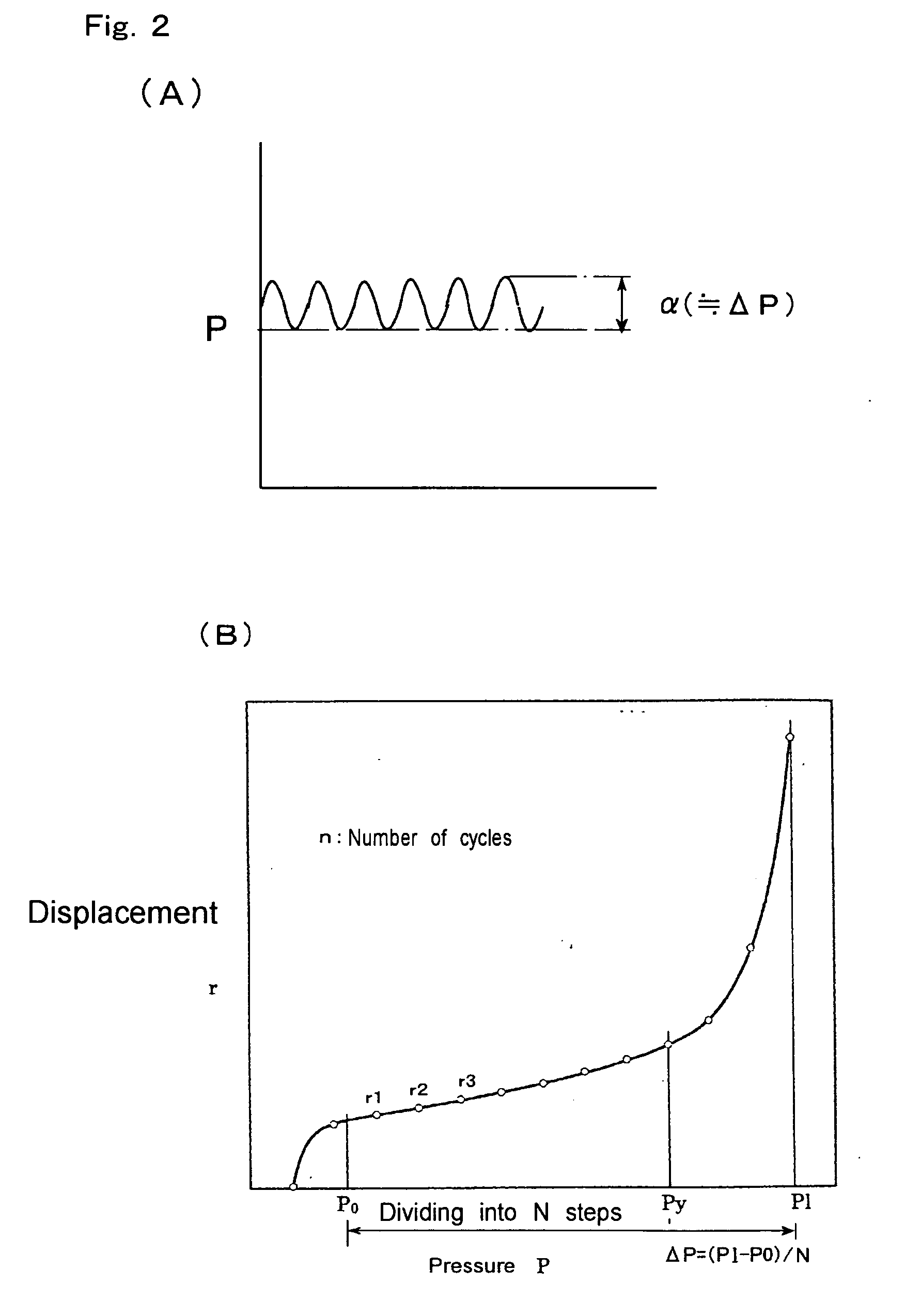Testing method and apparatus ground liquefaction and dynamic characteristics in original position utilizing boring hole
a testing method and apparatus technology, applied in the field of testing methods and apparatus, can solve the problems of out of scope for its use, machinery vibration, and difficult to perform soil sampling in an undisturbed manner, and achieve the effects of rapid change in the displacement of the bore-hole wall, time and cost saving, and soil properties can also be examined
- Summary
- Abstract
- Description
- Claims
- Application Information
AI Technical Summary
Benefits of technology
Problems solved by technology
Method used
Image
Examples
example 1
[0040]FIG. 1(A) shows the schematic illustration of the testing apparatus materializing the working example 1.
[0041] This testing apparatus is composed of an inflatable membrane zonde 201, which is lowered down into a bore-hole 100, and apply the pressures onto a bore-hole wall via a liquid medium such as water 203 in the zonde 201, a control unit which can pressurize the liquid medium such as water 203 in the zonde 201, and fluctuate periodically the amplitudes of the pressures in the zonde 201 via a pressure regulator 205, and a device 208 which implements the measurement of the displacements of the bore-hole wall.
[0042] In the working example, the water 203 is reserved in the tank 2 on the ground surface. The pressurized air is supplied to a top portion of the water tank 202 from the pressure supplying unit 204. This pressurized air is supplied via the pressure regulator 205 to the water 203 stored in the Water tank 202. Instead of regulating the air pressure, the Water pressur...
working example 2
[0080] The working example 2 is described below.
[0081]FIG. 7 shows the general layout of the in-situ testing apparatus in the present invention, which is aimed at exploring the dynamic properties of soils using bore-holes.
[0082] In the working example 1 described above, the cyclic loading is employed only on one location with a single cell of the zonde. However, in the working example 2, the cyclic loading is alternatively imposed on the top and bottom parts of the soil layer, J1 and J3, in such a manner that the soil element at the central part, J2, is subjected to cyclic shear stress.
[0083] Herein, the membrane zonde 110, which is lowered down into a bore-hole 100, is composed of three independent cells, 1st Cell 111, 2nd cell 112 and 3rd cell 113, which are failed with a liquid medium. The 1st cell 111 and 3rd cell 113 are alternatively cyclically excited by the 1st controlling device 121 and the 3rd controlling device 123, while the 2nd cell is statically pressurized by the 2...
working example 3
[0126] The working example 3 for the test apparatus aimed at exploring in-situ the liquefaction and dynamic characteristics of soils using bore-hole is described.
[0127] In the above working example 2 the zonde which is inserted into a bore-hole is made up of separate multiple cells, which can apply the pressures independently to the corresponding soil layers via liquid media filled in the cells. The pressure and displacement at the bore-hole wall at each cell are monitored. The zonde is made up of three cells, i. e. a central cell at which the static loading is applied, and top and bottom cells at which the cyclic loading is applied alternatively with one another. By applying the cyclic loading alternatively to the top and bottom cells, the pressure and displacement at the central cell is monitored and examined, which are supposed to undergo some effects of cyclic loading on the top and bottom cells.
[0128] However, the effects of cyclic loading imposed by the top and bottom cells ...
PUM
 Login to View More
Login to View More Abstract
Description
Claims
Application Information
 Login to View More
Login to View More - R&D
- Intellectual Property
- Life Sciences
- Materials
- Tech Scout
- Unparalleled Data Quality
- Higher Quality Content
- 60% Fewer Hallucinations
Browse by: Latest US Patents, China's latest patents, Technical Efficacy Thesaurus, Application Domain, Technology Topic, Popular Technical Reports.
© 2025 PatSnap. All rights reserved.Legal|Privacy policy|Modern Slavery Act Transparency Statement|Sitemap|About US| Contact US: help@patsnap.com



